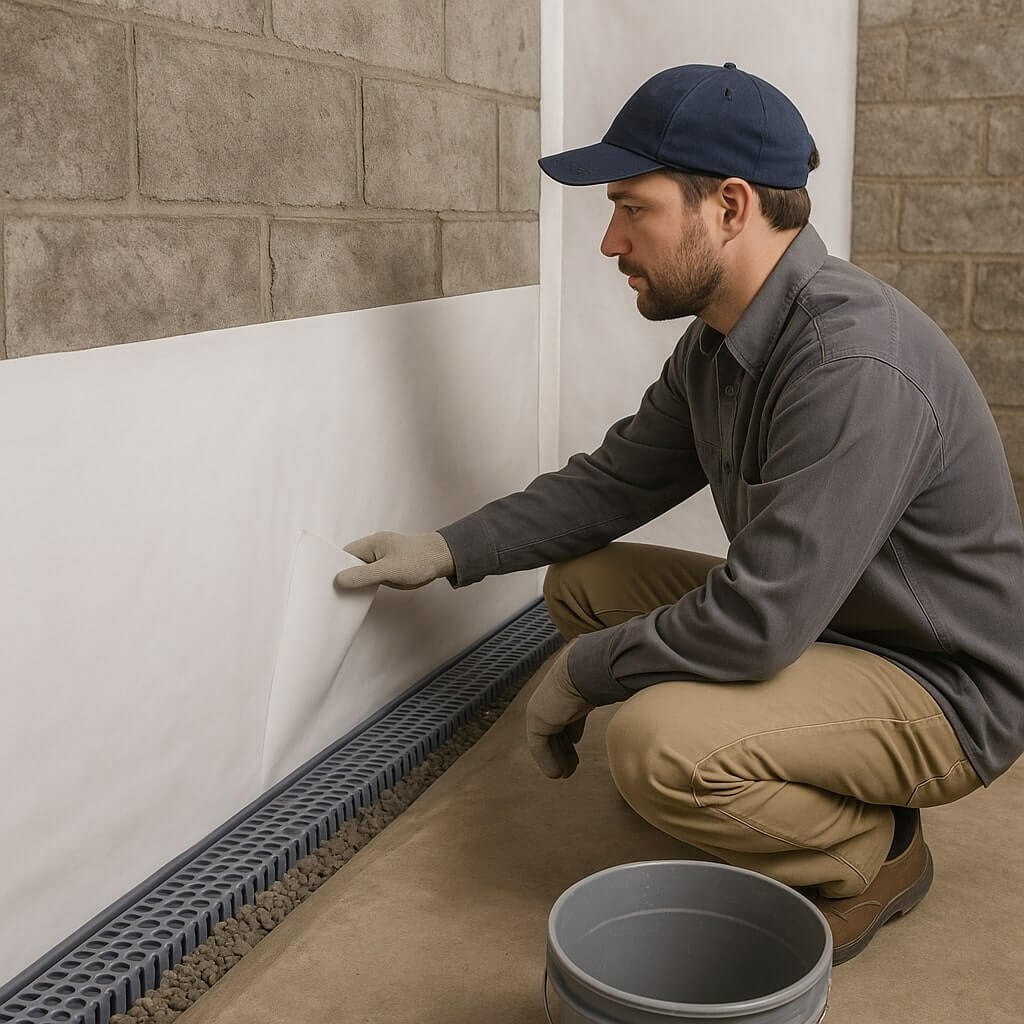If you own a basement in Oklahoma City, waterproofing is essential to prevent moisture issues. Start by evaluating your basement’s current condition, then move on to improve drainage outside your home. With the right steps, you can create a dry and healthy space below ground. Curious about the best methods to guarantee your basement stays dry through the seasons? Let’s explore some effective strategies.
Key Takeaways
- Regularly inspect for moisture signs, such as damp spots and mold, to identify issues before waterproofing your basement.
- Improve exterior drainage by maintaining gutters and grading soil to slope away from the foundation.
- Install a sump pump to manage water intrusion effectively, considering battery backup options for outages.
- Apply high-quality waterproof sealants to cracks in walls and floors, ensuring proper surface preparation for adhesion.
- Use dehumidifiers to maintain ideal humidity levels, preventing mold growth and protecting belongings in your basement.
Assess Your Basement’s Current Condition
Before you start waterproofing your basement, it’s crucial to assess its current condition to identify any existing issues.
Begin by checking for signs of basement moisture, such as damp spots, mold, or musty odors. Inspect walls and floors for cracks, as these can compromise your basement’s structural integrity.
Look for any water stains or efflorescence, which indicate previous leaks. Don’t forget to examine windows and doors for proper sealing.
Improve Exterior Drainage
After identifying any existing issues in your basement, it’s time to focus on improving exterior drainage to prevent future water problems.
Start with regular gutter maintenance; clean out leaves and debris to guarantee water flows freely away from your home.
Next, consider drainage solutions like installing downspout extensions that direct water at least six feet from your foundation.
You might also want to grade the soil around your home, sloping it away from the foundation.
Additionally, check for any low spots that can collect water and fill them in to minimize pooling.
These steps will greatly reduce water intrusion risks.
Install a Sump Pump
Installing a sump pump is a crucial step in protecting your basement from water damage, especially if you live in an area prone to flooding or heavy rainfall. During sump pump installation, consider different sump pump types, such as submersible or pedestal pumps, to find the best fit for your needs.
| Sump Pump Type | Pros | Cons |
|---|---|---|
| Submersible | Quiet, efficient | Higher initial cost |
| Pedestal | Easier to access | Noisy during operation |
| Battery Backup | Works during outages | Requires maintenance |
| Water Powered | No electricity needed | Limited capacity |
| Combination | Dual protection | More complex setup |
Use Waterproof Paint or Sealant
When you’re ready to protect your basement, using quality waterproof paint or sealant is essential.
Make sure you apply it correctly by following the manufacturer’s instructions for the best results, as improper application can lead to costly repairs later.
Don’t forget to schedule regular maintenance and reapplication to keep your basement dry and safe year-round.
Choose Quality Products
Choosing quality products is essential for effective basement waterproofing, as the right materials can greatly enhance your protection against moisture.
Look for waterproof paints or sealants specifically designed for basement use; they provide superior protection and longevity.
Consider quality product recommendations from trusted sources, and don’t hesitate to read customer reviews to gauge effectiveness.
Conduct a product durability analysis to verify the chosen materials can withstand Oklahoma City’s unique climate challenges.
Investing in high-quality products now can save you from costly repairs later, so prioritize durability and reliability for long-lasting results in your basement waterproofing efforts.
Proper Application Techniques
After selecting high-quality waterproof paints or sealants, applying them correctly is essential for achieving the best results in your basement waterproofing project.
Start with thorough surface preparation; clean and repair any cracks or imperfections to guarantee proper adhesion. Use a wire brush or scraper to remove loose debris and old paint.
Once the surface is prepped, apply the waterproof product using a roller or brush for even coverage. Follow the manufacturer’s instructions regarding drying times between coats.
Be mindful of temperature and humidity, as these factors can affect your application techniques and the overall effectiveness of the waterproofing process.
Maintenance and Reapplication
To keep your basement waterproof and free from moisture, it’s essential to regularly inspect and maintain the waterproof paint or sealant you applied.
Create a maintenance schedule to check for any cracks, peeling, or areas where water might seep through. Depending on the product you used, your reapplication frequency might vary, but it’s generally recommended every 5 to 10 years.
If you notice any deterioration, reapply the sealant promptly to guarantee maximum protection.
Regular maintenance not only extends the life of your waterproofing but also prevents costly repairs in the future.
Stay proactive for a dry, safe basement.
Repair Cracks in Walls and Floors

To keep your basement dry, it’s essential to repair any cracks in the walls and floors.
Start by identifying common crack types and determine the appropriate sealant for each.
Once you apply the sealant, make sure to monitor for new cracks regularly to maintain a waterproof environment.
Identify Common Crack Types
While it might seem challenging, identifying common crack types in your basement walls and floors is essential for effective waterproofing and repair.
Recognizing these cracks can help you address potential foundation issues before they worsen. Here are three common crack types to look for:
- Vertical Cracks: Often caused by settling, these usually indicate minor foundation issues.
- Horizontal Cracks: These can signal serious foundation problems due to soil pressure.
- Diagonal Cracks: Often a mix of settling and soil shifts, these can vary in severity.
Understanding these crack types will guide your repair efforts and improve your basement’s waterproofing.
Apply Sealant Properly
Applying sealant properly is essential for effective waterproofing and preventing water damage in your basement.
Start by choosing the right sealant types, such as epoxy or polyurethane, based on the crack’s size and location. Clean the area thoroughly to guarantee proper adhesion.
Using application tools like a caulking gun or putty knife, fill the cracks, making sure to push the sealant deep into the gaps. Smooth the surface with a tool or your finger for an even finish.
Allow the sealant to cure as per the manufacturer’s instructions, guaranteeing a reliable barrier against moisture infiltration in your basement.
Monitor for New Cracks
As you work to keep your basement waterproof, it’s important to regularly monitor for new cracks in the walls and floors.
This crack monitoring is vital for maintaining your basement’s structural integrity. Here are three steps to help you:
- Inspect Regularly: Check walls and floors monthly for any signs of new cracks.
- Use a Moisture Meter: This tool can help you identify damp areas that may indicate cracks forming.
- Document Changes: Keep a log of any cracks you find, noting their size and location for future reference.
Addressing new cracks promptly can prevent costly repairs and further damage.
Ensure Proper Ventilation
How can you effectively guarantee proper ventilation in your basement to prevent moisture buildup?
Start by exploring various ventilation methods, such as installing exhaust fans or using dehumidifiers to control indoor humidity. Open windows when possible, but make certain that outdoor air isn’t damp.
Circulate air with box fans or ceiling fans to eliminate stagnant areas. Additionally, consider installing vents that connect to the outside to promote airflow.
Regularly monitor humidity levels with a hygrometer, aiming to keep it below 60%. By maintaining consistent ventilation, you’ll minimize moisture and create a healthier basement environment.
Install a French Drain

Installing a French drain is a smart way to redirect water away from your basement, preventing flooding and moisture issues.
You’ll need to understand the basics of how these systems work, the installation steps involved, and ongoing maintenance to keep it effective.
Let’s break down each of these points to guarantee your basement stays dry and protected.
French Drain Basics
When water seeps into your basement, a French drain can be a lifesaver in managing that moisture and preventing damage.
Understanding the different French drain types and their installation is essential for effective basement waterproofing. Here are three key considerations:
- Surface French Drains: Ideal for collecting water from the ground surface, directing it away from your foundation.
- Subsurface French Drains: Installed below ground to intercept groundwater before it reaches your basement.
- Trench Drains: Perfect for areas prone to flooding, channeling water efficiently away.
Choosing the right type and ensuring proper installation can protect your home from water damage.
Installation Process Overview
Before you begin the installation of a French drain, it’s crucial to plan the layout and gather the necessary materials to guarantee a smooth process.
You’ll need perforated pipe, gravel, and landscape fabric as your primary installation materials.
First, dig a trench along the planned route, ensuring a slope for proper drainage. Lay down landscape fabric to prevent soil from clogging the drain.
Next, position the perforated pipe at the bottom of the trench and cover it with gravel.
This waterproofing technique effectively redirects water away from your basement, helping to keep it dry and protected from moisture damage.
Maintenance Tips Needed
Regular maintenance is essential to guarantee your French drain operates effectively and continues to protect your basement from moisture.
To ensure peak performance, follow these preventative measures and seasonal checks:
- Clear Debris: Regularly remove leaves, dirt, and other obstructions from the drain’s surface to prevent blockages.
- Inspect Water Flow: After heavy rain, check that water is flowing freely through the drain. Look for any signs of pooling or slow drainage.
- Test the System: Periodically run water through the drain to assess its efficiency and identify any potential issues early on.
Staying proactive will help you avoid costly repairs down the line.
Use a Dehumidifier
Using a dehumidifier can greatly enhance your basement’s waterproofing efforts by reducing excess moisture in the air.
These devices offer significant dehumidifier benefits, including preventing mold growth and protecting your belongings from damage.
By maintaining ideal humidity control, you create a healthier living environment and minimize the risk of structural issues.
When choosing a dehumidifier, consider the size of your basement and its moisture levels.
Regularly empty the water reservoir or opt for a continuous drainage option to guarantee efficient operation.
With proper use, a dehumidifier can be an essential tool in keeping your basement dry and comfortable year-round.
Landscape Grading for Water Runoff
When it comes to preventing water from pooling in your basement, effective landscape grading is essential. Proper grading directs water away from your foundation, reducing the risk of flooding.
Here are three key steps to take into account:
- Assess Your Soil Type: Different soils drain differently; clay retains water, while sandy soil allows it to flow.
- Establish a Slope: Aim for a 2% slope away from your home to promote drainage.
- Implement Drainage Solutions: Utilize French drains or swales to manage excess water effectively.
Regular Maintenance and Inspections
One critical aspect of keeping your basement dry and free from water damage is conducting routine maintenance and inspections. Establishing a maintenance routine can help you identify potential issues before they escalate. Here’s a simple table to guide your efforts:
| Task | Frequency | Purpose |
|---|---|---|
| Inspect gutters | Monthly | Prevent overflow |
| Check sump pump | Quarterly | Guarantee functionality |
| Look for cracks | Semi-annually | Detect leaks early |
Conclusion
By following these ten essential tips, you can effectively waterproof your basement in Oklahoma City and protect your home from moisture-related issues. Regularly assess your basement’s condition, maintain drainage systems, and invest in quality sealants and pumps. Don’t forget the importance of landscaping and dehumidifiers in managing humidity levels. With consistent maintenance, you’ll guarantee a dry, healthy environment in your basement, safeguarding your investment and enhancing your living space.




